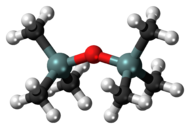
| |

| |
| Names | |
|---|---|
| Preferred IUPAC name
Hexamethyldisiloxane | |
Other names
| |
| Identifiers | |
3D model (JSmol)
|
|
| Abbreviations | HMDSO, (TMS)2O |
| 1736258 | |
| ChEBI | |
| ChemSpider | |
| ECHA InfoCard | 100.003.176 |
| EC Number |
|
| MeSH | Hexamethyldisiloxane |
PubChem CID
|
|
| RTECS number |
|
| UNII | |
| UN number | 1993 |
CompTox Dashboard (EPA)
|
|
| |
| |
| Properties | |
| C6H18OSi2 | |
| Molar mass | 162.379 g·mol−1 |
| Appearance | Colourless liquid |
| Density | 0.764 g·cm−3 |
| Melting point | −59 °C (−74 °F; 214 K) |
| Boiling point | 100 to 101 °C (212 to 214 °F; 373 to 374 K) |
| 930.7±33.7 ppb (23 °C) [1] | |
| Vapor pressure | 43 hPa (20 °C) [2] |
Refractive index (nD)
|
1.377 |
| Hazards | |
| Occupational safety and health (OHS/OSH): | |
Main hazards
|
|
| GHS labelling: | |
  [2] [2]
| |
| Danger[2] | |
| H225, H410[2] | |
| P210, P233, P240, P273, P403+P235[2] | |
| NFPA 704 (fire diamond) | |
| Flash point | −1(1) °C |
| Related compounds | |
Related compounds
|
|
Except where otherwise noted, data are given for materials in their standard state (at 25 °C [77 °F], 100 kPa).
| |
Hexamethyldisiloxane (HMDSO or MM) is an organosilicon compound with the formula O[Si(CH3)3]2. This volatile colourless liquid is used as a solvent and as a reagent in organic synthesis. It is prepared by the hydrolysis of trimethylsilyl chloride. The molecule is the protypical disiloxane and resembles a subunit of polydimethylsiloxane.
- ^ Sudarsanan Varaprath; Cecil L. Frye; Jerry Hamelink (1996). "Aqueous solubility of permethylsiloxanes (silicones)". Environmental Toxicology and Chemistry. 15 (8): 1263–1265. doi:10.1002/etc.5620150803.
- ^ a b c d e Record of Hexamethyldisiloxane in the GESTIS Substance Database of the Institute for Occupational Safety and Health, accessed on November 10, 2021.
